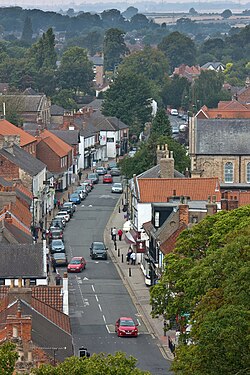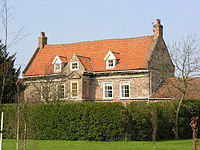Cottingham, Yorkshire
| Cottingham | |
| Yorkshire East Riding | |
|---|---|
 Hallgate, from the church tower | |
| Location | |
| Grid reference: | TA046329 |
| Location: | 53°46’56"N, 0°24’49"W |
| Data | |
| Population: | 17,164 (2011) |
| Post town: | Cottingham |
| Postcode: | HU16 |
| Dialling code: | 01482 |
| Local Government | |
| Council: | East Riding of Yorkshire |
| Parliamentary constituency: |
Haltemprice and Howden |
Cottingham is a large village in the East Riding of Yorkshire. It forms part of the urban area of Kingston upon Hull, standing four miles north-west of the city centre, and six miles south-east of Beverley on the eastern edge of the Yorkshire Wolds.
The village has two main shopping streets, Hallgate and King Street, which cross each other near the parish church, and a market square called Market Green.
Cottingham had a population of 17,164 residents recorded in 2011, making it larger by area and population than many towns. As a result, it is one of the villages claiming to be the ‘largest village in England’.[1]
Church
The parish church is the Church of St Mary the Virgin. It was built between 1272 and 1370 in a mixture of the decorated and perpendicular Gothic styles. The tower was built in the 15th century. [2]
The church is a Grade I listed building.[3]
History
The pre-Conquest owner of Cottingham was Gamel, the son of Osbert, during the reign of Edward the Confessor in the 11th century.[4] After the Norman Conquest, the land was in the possession of Hugh fitzBaldric. At this time, the Domesday Book (1086) shows the Cottingham manor included a mill, five fisheries, woodland and farm land.[5] In 1089 the manor was given to Robert Front de Boeuf, founder of the de Stuteville family line, after FitzBaldric's Yorkshire lands forfeited.[6]
In 1201, a licence to fortify was obtained by William de Stuteville, marking the beginnings of Baynard Castle. In 1319, Thomas de Wake received a charter allowing Cottingham to have two annual fairs and a weekly market; he also founded an Augustinian priory, licensed in 1320, and built by 1322. Due to potential disputes over the land it was built on, the priory moved to Newton south of Cottingham in 1325, becoming known as Haltemprice Priory.
After 1376, dikes were made to supply water to Kingston upon Hull with fresh water from a source between Cottingham and Anlaby; in 1392, some inhabitants of Cottingham and Anlaby rioted, and about 1,000 people laid siege to Kingston upon Hull, threatening to raze it to the ground. The siege was ultimately unsuccessful with some of the ringleaders hanged at York; their complaint was the extraction of water which they said had deprived them of water, as well the dike having damaged their fields.
After 1402, the water supply of Hull was further improved, bringing more hostility from the surrounding area; the construction of the channel was sabotaged, and the builders attacked; later salt water was let into the Hull supply, and the water was tainted with the carcasses of dead animals. Disputes over the matter continued and provoked an appeal to the Pope.
"In the Spring Time, near a thousand Persons, belonging to Cottingham, Woolferton, Anlaby and other neighbouring Towns, being offended, that the Inhabitants of Hull, had, by cutting the Earth, drawn some fresh Water from them; they bound themselves, with a terrible Oath, to stand by one another whilst they were able shed their last Drops of Blood. Then, having ordain'd the most rustical Leaders, they appear'd in the like Sort of Arms, ransacking Houses, and abusing such Owners, who would not as madly confederate with them. Soon did they lay Siege to Hull, vowing the utter Destruction of it. Being strangely poetically given too, they made such insipid Rhimes, to encourage the Seditious, as indeed would dishonour the Flights of Antiquity, should such ridiculous Stuff be publickly set forth. The Canals, which had been made at vast Expence, they quickly fill'd up, almost as they had been before. But tho' by these Means they had spitefully deprived the Town of fresh flowing Streams, and stopt Provisions that were sent to the valiant Inhabitants; yet these ill-advised Wretches found themselves too much much deluded, and withal too impotent, to prevail against them. Upon which, withdrawing to Cottingham; and afterwards, through Fear, dispersing; some fled quite away; others, taken, and sent to York, were executed; and about 30 obtain'd Pardon, upon their Penitence, and faithful Promise, never to attempt the like again."}}[7]By 1661, the manor house of Southwood Hall had been built to the south-east of the village. Today it is a Grade II* listed building.[8]
A Georgian villa, later known as 'Kingtree House' was built on King Street around 1750 by Hull merchant Samuel Watson. The gardens were noted by Arthur Young on his tour of Yorks' and surrounding counties around 1770.
"At this place Mr. Watson has a pleasure-ground, which is very well worth seeing; it consists of shrubberies with winding walks, and the imitation of a meandering river through the whole..."[9]Snuff was manufactured in the south of the village in the 18th century; towards the end of the century a large mill owned by Quaker William Travis was producing 15 hundredweight of snuff per week.[10] William Travis had a three storied house built in 1750 next to the mill.[11] William Travis also acquired land on Thwaite Street in the 1770s and by 1795 had built Cottingham Hall, one of the largest dwellings in the village;
Several notable houses and halls were constructed in and around Cottingham at around the turn of the 19th century: to the north-west of the village; Cottingham Grange (built 1801);
The rail network reached Cottingham in October 1846, with the opening of Cottingham railway station and the Hull and Bridlington Railway extension of the Hull and Selby Railway. Cottingham station was built close to and east of the village centre. This drove housing development for the middle classes of Hull; resulting in the construction of terraced and semi-detached villas.
By the 1850s Cottingham was a substantial village, with housing along its main streets of Northgate, Hallgate, King Street, Newgate Street, South Street, and Thwaite Street.
During the Second World War, a temporary camp (Harland Way Camp) was constructed near Cottingham Grange. Initially, it housed refugees, and it later became an army transit camp.
The village became increasingly urbanised in the first half of the 20th century, particularly by terraced housing. Additionally the road to Hull was developed, with housing near continuous along it by the 1950s.[12] During the interwar period the boundaries of Hull were expanded, taking in part of Cottingham; the North Hull Estate was constructed on the north-west fringe of the city in the 1930s, and by mid-century, only a narrow strip of green space separated Hull from Cottingham on its eastern boundary near 'New Village'.[13][14]
After the War, extensive urban development and expansion took place, in particular to the south of the village.
Sport and leisure and society
- Scouts etc: Scouts, Cubs, Beavers, Guide, Brownies and Rainbows, and Ranger.
To the north of the village is King George V Playing Field.
Hull City A.F.C.'s training ground is located on Millhouse Woods Lane.
Outside links
("Wikimedia Commons" has material
about Cottingham, Yorkshire)References
- ↑ "Could Cottingham be the largest village in England?". Yorkshire Life. 3 February 2011. http://www.yorkshirelife.co.uk/out-about/places/could-cottingham-be-the-largest-village-in-england-1-1642761.
- ↑ Nikolaus Pevsner: The Buildings of England: Yorkshire: York & East Riding, 1972; 1995 Penguin Books ISBN 978-0-300-09593-7
- ↑ National Heritage List 1103394: Church Of St Mary (Grade I listing)
- ↑ "Bulmer's History and Directory of East Yorkshire". www.genuki.org.uk. 1892. http://www.genuki.org.uk/big/eng/YKS/ERY/Cottingham/Cottingham92.html.
- ↑ Sources:
- ↑ Cottingham, Yorkshire in the Domesday Book
- ↑
- {{cite book| url=https://archive.org/details/historyofhullann00gent |title=History of Hull (Annales Regioduni Hullini) |year=1869| first=Gent|last=Thomas|orig-year=1735| at=pp. 90–94
- ↑ National Heritage List 1310021: Southwood Hall (Grade II* listing)
- ↑ Arthur Young: A six months tour through the north of England.
- ↑ Sheahan, James Joseph (1864). General and concise history and description of the town and port of Kingston-upon-Hull. Simpkin, Marshall & Co.. p. 303. https://archive.org/details/generalconcisehi00shea.
- ↑ National Heritage List 1103397: Snuff Mill House and railings (Grade II listing)
- ↑ Ordnance survey. 1:2500: 1910; 1927–8. 1:10560: 1910–11; 1938–52; 1956. 1:63360: New Popular edition 1945-7 (1947); Seventh Series 1952–61 (1959)
- ↑ Neave, David; Neave, Susan (2010). Hull. Yale University Press. pp. 25–6. ISBN 978-0-300-14172-6.
- ↑ Ordnance survey. 1:10560. 1956
- Allison, K. J. (1981). Hull Gent. Seeks Country Residence, 1750–1850. East Yorkshire Local History Society. ISBN 978-0900349362., account of extra-urban development of large houses for wealthy merchants of Hull
- Gale, I. N.; Rutter, H. K.; Adams, B.; Bloomfield, J. P.; Coleby, L.; Fenwick, S.; Smedley, P. L.; Sumbler, M. G. (2006). The Chalk aquifer of Yorkshire. Research Report RR/06/04. British Geological Survey, Natural Environment Research Council. ISBN 0-85272-480-2. http://nora.nerc.ac.uk/3700/1/RR06004.pdf.
- Oliver, George (1829). "Part IV. Historical Account of the adjacent Villages: 1. Cottingham". The history and antiquities of the town and minster of Beverley, in the county of York, from the most early period: with historical and descriptive sketches of the abbeys of Watton and Meaux, the convent of Haltemprise, the villages of Cottingham, Leckonfield, Bishop and Cherry Burton, Walkington, Risby, Scorburgh, and the hamlets comprised within the liberties of Beverley. M. Turner. pp. 458–471. https://books.google.com/books?id=LYYKAQAAMAAJ&pg=PA458.
- Overton, Charles (1861). The history of Cottingham. J.W. Leng. https://books.google.com/books?id=WbwHAAAAQAAJ.
- Pevsner, Nikolaus; Neave, David (1995). "Cottingham". Yorkshire: York And the East Riding, Second Edition. Yale University Press. pp. 385–392. ISBN 0-300-09593-7. https://books.google.com/books?id=bcp5soQZ0OwC&pg=PA385.
- Sheahan, J. J.; Whellan, T. (1856). "Cottingham". History and topography of the city of York; the Ainsty wapentake; and the East riding of Yorkshire. 2. pp. 535–541. https://books.google.com/books?id=3cEHAAAAQAAJ&pg=PA535.
- "Cottingham Parish Council". Cottingham Parish Council. http://www.cottinghamparishcouncil.org.uk/.
- Gazetteer — A–Z of Towns Villages and Hamlets. East Riding of Yorkshire Council. 2006. p. 4.
- "Remarkable spirit of a community". This is Hull and East Riding (Northcliffe Media). 13 July 2009. http://www.thisishullandeastriding.co.uk/goolelocal/news/8216-Remarkable-8217-spirit-community/article-1092891-detail/article.html.




